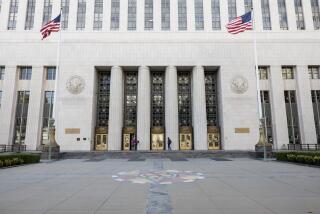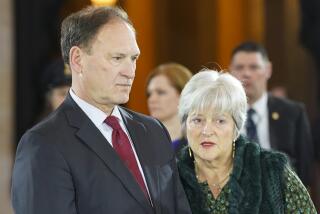Legal Eagles Tip Off in ‘Highest Court in the Land’
WASHINGTON — The Supreme Court building is home to two courts. There’s the fancy place with red velvet curtains and robe-wearing justices, and the one with bland concrete walls and backboards, where the attire is sweats and sneakers.
The unofficial court is for basketball. It’s in a secluded area on the building’s top floor, not listed in tourist information and closed to visitors.
Known informally as the “highest court in the land,” it’s the place for matchups of justices, law clerks and fill-in players from the police force, cafeteria and clerk’s office.
“It’s certainly not to be confused with Boston Garden, but I don’t think anybody ever complained,” said Kevin Kearney, a former clerk who practices law in Buffalo, N.Y.
When the building was constructed in the 1930s, the area was designed as a spare space for journals. In the 1940s -- archivists cannot definitively say why or when -- wood backboards were installed.
Since then, players have trekked through the law library and up a flight of stairs. A combination is required for entry into what looks like a junior high gym. A sign warns competitors to watch the noise because the real courtroom is directly below. “How much closer to basketball heaven can you get than that?” said University of Georgia law professor Dan Coenen, a clerk from 1979-80.
Pickup games are routine at lunchtime or afternoons, mostly for the young clerks.
Richard Garnett’s only question during his 1995 interview for a clerkship was about the court’s court. “I asked to see the court and to shoot just one shot. It struck me that it would likely be my only chance,” recalled Garnett, who later got to shoot hoops any time he liked as a clerk for Chief Justice William H. Rehnquist.
None of the current nine justices plays -- their average age is 68.
But Justice Sandra Day O’Connor uses the court for women-only classes of yoga-style aerobics. And some justices use weights in a small adjoining gym.
The legendary basketball-playing justice was Byron White, a highly competitive onetime pro football player who died earlier this year. He shot hoops even into his 70s, matching up against Justice Clarence Thomas several times before retiring in 1993.
White wasn’t on the court when Thomas tore his Achilles tendon during a game, an injury that ended Thomas’ playing days.
Asked by a colleague if he was responsible for the injury, White said, apparently in jest: “If I’d done it, it would have been both legs.”
White invited his clerks to join him on the court each afternoon.
“His saying was, ‘Shall we clear the cobwebs, guys?’ ” said Lee Albert, a professor at the State University of New York at Buffalo Law School who clerked for White from 1963-65. “These are Type A personalities who do not need much prompting anyway.”
Charles Lettow, a Washington attorney who clerked for then-Chief Justice Warren E. Burger in 1969-70, said players knew that if they tried to roughhouse White, “you’d get laid out on the floor.”
Lettow’s daughter, Renee Lettow Lerner, as an appeals court clerk in 1996-97, once played in a tournament pitting female appeals court clerks against female clerks of the high court, who called themselves the Supreme Women. The matchup was close, but no one knows how close because the players didn’t keep score.
The court has had some upgrades. A new floor was installed in 1984, and wooden backboards were replaced with Plexiglas in 1997. But there still aren’t any benches and the court itself is smaller than regulation-size.
Despite that, the court remains a major perk for clerks. “You have the best legal job in the country and, oh my gosh, there’s basketball too,” said Anne Coughlin, a clerk in 1985-86 who teaches law at the University of Virginia.
More to Read
Go beyond the scoreboard
Get the latest on L.A.'s teams in the daily Sports Report newsletter.
You may occasionally receive promotional content from the Los Angeles Times.










